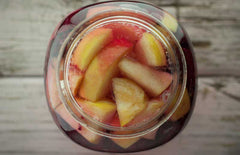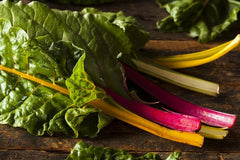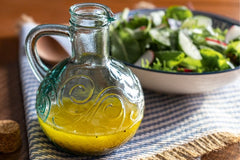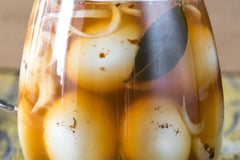How To Make Lacto-Fermented Peach Chutney – Tips & Recipe

What Is Lacto-Fermentation?
Lacto-fermentation is a great way to preserve foods. Not only that but the result tastes amazing and is very nutritious. Most foods preserved using the lacto-fermentation method contain lots of probiotics that are great for your health.
Lacto-fermentation gives the food an acidic taste. That’s why many people think only vegetables can be preserved this way. However, this is far from the truth. Fruits can also be lacto-fermented and, if you are creative, you can come up with some amazing and delicious combinations. Like the lacto-fermented peach chutney we’re going to prepare today.
Lacto-Fermentation Tips & Tricks
Before discussing the wonderful peach chutney, let us share some general tips and tricks that will help you to prepare other delicious lacto-fermented fruit chutneys.
As a general rule, all you need for Lacto-fermentation is chopped, sliced, grated or whole vegetable or fruits, water, and salt. However, you can add your favorite spices and herb to the mix to alter the taste and make it better.
If you choose to chop, grate or slice the fruits or veggies, add salt before you add them to the fermentation jar. Once the veggies or fruits are in the jar, cover it with a lid and give it a vigorous shake to release the juices.
It is important to remember that during the lacto-fermentation process, the fruits and vegetables need to be fully submerged in the brine so they can ferment properly. Also, you want to store your fermentation jar at room temperature to enable the production of good bacteria.
To prevent mold from forming, make sure the veggies or fruits are fully submerged in the brine and that the jar is sealed with a lid. The fermentation process doesn’t require oxygen. In fact, it works better without oxygen because it prevents mold from forming at the top of the jar.
Using salt prevents unwanted bacteria to take over the lactobacillus, the bacteria that enables the fermentation process, so salt is needed in the lacto-fermentation process. Salt also maintains the crunch of the vegetables and fruits. However, if you don’t want to use salt or you are required to reduce your sodium intake, there are alternatives you can use. The vegetable starter culture is a great alternative and is available in many grocery and online stores. Seaweeds are another great alternative to salt but they are high in sodium.
For the fermentation part, you’ll need a regular mason jar. But the most important part is the lid. You want a lid that facilitates the lacto-fermentation process and keeps the mold away. Like our Easy Fermenter Lids. If you use these lids, you don’t have to monitor for mold and you don’t have to change the lid when the lacto-fermentation process is finished. These lids have a waterless airlock valve that is specifically designed for fermenting.
Lacto-Fermented Peach Chutney Recipe
Ingredients:- 16 peaches
- 2 cups raisins;
- 2 cups pecans;
- 2 1/2 tablespoons sea salt;
- 5 lemons;
- 4 onions;
- 4 tablespoons fresh ginger;
- 4 hot peppers.
- Kitchen knife;
- Grater;
- Mason jars;
- Easy Fermenter Lids (not required)
- Fermenting Weights (not required)
- Cut the peaches in half and remove the core. Then chop them coarsely.
- Chop the pecans.
- Cut the lemons in half and juice them with your hand or with a citrus juicer.
- Chop the onions finely.
- With a grater, grate approximately 4 tablespoons of fresh ginger root.
- Chop the peppers. Ideally, you would use fresh peppers but dried peppers work too.
- In a mixing bowl, combine the chopped peaches with the pecans, lemon juice, chopped onions, grated ginger, raisins, and sea salt.
- Transfer the mixture to your fermentation jar and shake vigorously to release juices.
- Combine 4 cups of water with 2 tablespoons of salt to make the brine.
- Add the brine over the fruit mixture. Make sure there is one inch left below the top of the jar because, during the fermentation process, the mixture expands.
- Press the vegetables with a tablespoon to make sure they stay under the brine.
- Cover the jar with the Easy Fermenter Lid and place the Fermentation Weights in the jar to ensure perfect fermentation results.
- Place the jar in a warm spot to allow the chutney to ferment properly for 2-4 days.
- After a couple of days, you can open the jar and taste the chutney to see if you are satisfied with the taste. If you are, transfer the jar to the fridge. If not, allow the mixture to ferment for another day.
Want To Take Your Fermenting To the Next Level?
Enroll in our Fermenting Mastery Video Series. A complete set of detailed, step-by-step instructions that will give you the confidence to create ferments that you’re proud of, every single time. Even when you make up your own recipes and techniques! Included are 14 professionally recorded recipes - Over two hours of content to help you master your ferments.









